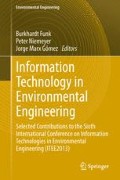Abstract
Along with the rapid growth of seaborne traffic volumes and rising public concern about environment, transport and logistics services are experiencing increasing pressures not only to improve their operational efficiency and reduce costs but also to minimize their environmental impacts. The requirement to become more sustainable is also inevitable for seaports and terminals, as significant nodes in the intermodal transport chain. A number of approaches on calculating and documenting carbon footprint are available for transport and logistics services, and many major ports and terminals have also started adopting them. The selection criteria of which methodology to be applied would finally depend on what a company wants to achieve. Nevertheless, it is crucial that the methodology should allow identification and focus on areas of improvements in order to develop an efficient energy saving and reduction measures and allow fair allocation of emissions. The objective of this chapter is to develop an applicable carbon footprint measurement framework for ports and terminals to serve three principals: a transparent and standardized CO2-equivalent -measurement method, a consistent reporting scheme and an effective management system for ports and terminals. To achieve this, an assessment on selected existing methodologies and identification of key factors for calculation of carbon footprint at a container terminal will be performed and elucidated.
Access this chapter
Tax calculation will be finalised at checkout
Purchases are for personal use only
References
Van Duin JHR, Geerlings H (2011) Estimating CO2 footprints of container terminal port-operations. Int J Sustain Dev Plann 6(4):459–473, WIT Press
HHLA (2011) CO2 emissions per container handled. http://hhla.de/en/sustainability/overview/co2-emissions.html. Accessed on 7 Feb 2013
WPCI (2010) Carbon footprinting for ports, guidance document, port of Los Angeles. http://wpci.iaphworldports.org/carbon-footprinting/index.html. Accessed on 14 January 2011
Leonardi J, Browne M (2010) A method for assessing the carbon footprint of maritime freight transport: European case study and results. Int J Logistics-Res Appl 13(5):349–358
Froese J et al (2011) Green and effective operations at terminals and in ports (Green EFFORTS) project. GreenPort Magazine, Hampshire
COFRET (2011) Existing methods and tools for calculation of carbon footprint of transport and logistics. http://www.cofret-project.eu/downloads/pdf/COFRET_Deliverable_2.1_final.pdf. Accessed on 7 Feb 2013
Froese, J and Toeter, S (2013) Reduction of carbon footprint of ports and terminals—fiction and reality. In: Proceedings of Greenport south Asia conference 2013, Mumbai
Wintergreen and Delaney, n.d., ISO 14064, International standard for GHG emissions inventories and verification. http://www.epa.gov/ttnchie1/conference/ei16/session13/wintergreen.pdf. Accessed on 12 April 2013
ISO (2006) EN ISO 14064-1, Greenhouse gases—part 1: specification with guidance at the organization level for quantification and reporting of greenhouse gas emissions and removals
Greenhouse Gas (GHG) Protocol (2004) A corporate accounting and reporting standard, Revised edition. http://www.ghgprotocol.org/files/ghgp/public/ghg-protocol-revised.pdf. Accessed on 7 Feb 2013
DIN Deutsches Institut für Normung (2012) EN 16258:2012 methodology for calculation and declaration on energy consumptions and GHG emissions in transport services (good and passengers transport)
ISO (2011) EN ISO 50001, Energy management systems—requirement with guidance for use
Froese J/Green EFFORTS (2012) Project topology, methodology and tools, Deliverable 3.1
Schwientek A, Froese J (2012b) Green EFFORTS Container terminal processes, Deliverable 3.2
GHG Protocol (2010) Corporate value chain (Scope 3) accounting and reporting standard. http://www.ghgprotocol.org/files/ghgp/public/GHG%20Protocol%20-%20Scope%203%20Standard%20-%20Executive%20Summary.pdf. Accessed on 7 Feb 2013
Gothenburg Port Authority (2012) Climate programme, step 1: carbon footprint calendar year 2011. http://www.goteborgshamn.se/Documents/PDF-bank/Gothenburg%20Port%20Authority%20Carbon%20footprint%202011%20-%20July%202012.pdf. Accessed on 7 Feb 2013
Jurong Port (2010) Jurong port carbon footprint report 2010. http://www.jp.com.sg/JurongPort/carbon-footprint-report/. Accessed on 7 February 2013
Port of LA (2011) Port of los angeles inventory of air emissions 2011. http://www.portoflosangeles.org/pdf/2011_Air_Emissions_Inventory.pdf. Accessed on 7 Feb 2013
Acknowledgments
This research is conducted in line with the GREEN EFFORTS, “Green and Effective Operations at Terminals and in Ports”, a collaborative research project co-funded by the European Commissions under the Seventh Framework Programme.
Author information
Authors and Affiliations
Corresponding author
Editor information
Editors and Affiliations
Rights and permissions
Copyright information
© 2014 Springer-Verlag Berlin Heidelberg
About this chapter
Cite this chapter
Lengkong, I., Froese, J. (2014). Key Factors for Measurement of CO2 Emissions. In: Funk, B., Niemeyer, P., Gómez, J. (eds) Information Technology in Environmental Engineering. Environmental Science and Engineering(). Springer, Berlin, Heidelberg. https://doi.org/10.1007/978-3-642-36011-4_18
Download citation
DOI: https://doi.org/10.1007/978-3-642-36011-4_18
Published:
Publisher Name: Springer, Berlin, Heidelberg
Print ISBN: 978-3-642-36010-7
Online ISBN: 978-3-642-36011-4
eBook Packages: Earth and Environmental ScienceEarth and Environmental Science (R0)

